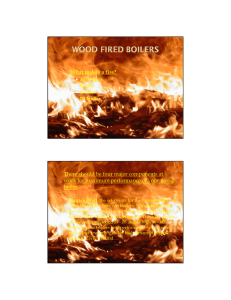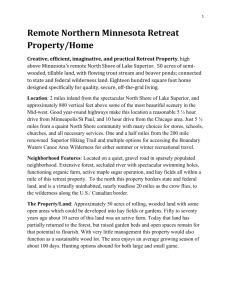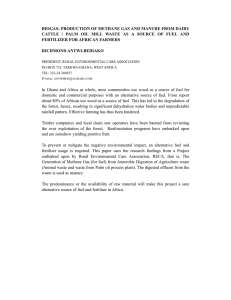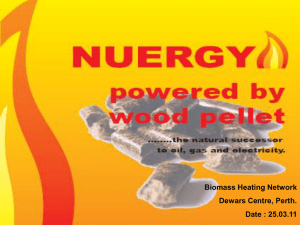Introduction to State-of-the-Art Commercial-Scale Wood Pellet and Wood Chip Boiler Systems
advertisement
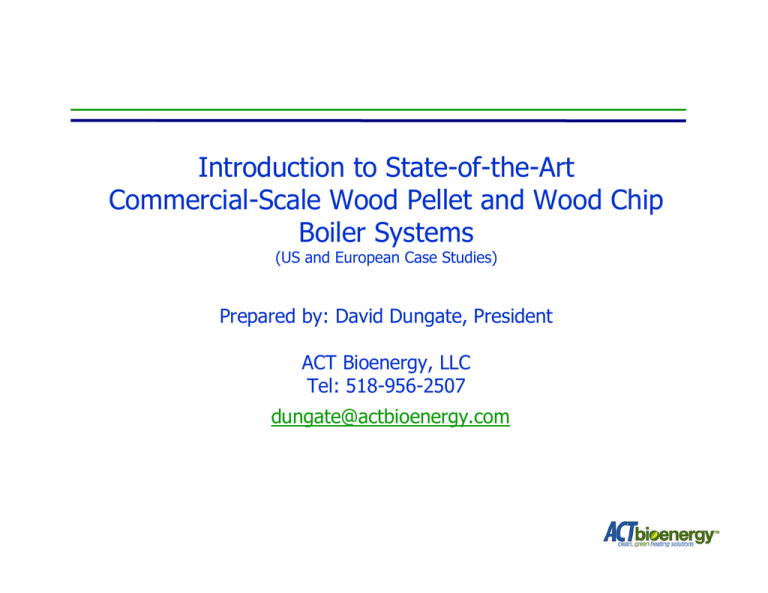
Introduction to State-of-the-Art Commercial-Scale Wood Pellet and Wood Chip Boiler Systems (US and European Case Studies) Prepared by: David Dungate, President ACT Bioenergy, LLC Tel: 518-956-2507 dungate@actbioenergy.com Current Situation •1/3 of US energy is used for heating and cooling buildings – more than transportation or manufacturing •1 ton of wood can replace 115 gal of heating oil and reduce CO2 by 2645 lbs. • Current logging in the Upstate NY generates more than 1 million tons of noncommercial wood residues/yr. – Enough to heat 3-4000 school buildings. New York Oil Economics 7.9 million New York Households 33% heat with oil Average oil price of $3.59/gal. over next 10 years Consumption = 2.34 Billion gallons/yr. avg. Cost = $8.4 Billion/yr. and $6.3 Billion/yr. leaves US If 10% of homes convert to wood pellet heating over 10 years > 1000 direct jobs and 61,000 multiplier jobs in New York (Sources: EIA, Census, Strauss - Futuremetrics 2009) Fuel Cost Comparison in $/MMBtu $45.00 $40.00 $35.00 $30.00 $25.00 $20.00 $15.00 $10.00 $5.00 $- d o o W C ps i h $5 t 0/ o W od ll e P s et N 0/ 0 $2 ra u at t as lG 1 $1 C M / 0 .9 F F i O l e u 2. $ l / 75 l a g ne a op r P .7 2 $ ga / 0 l ric t ec l E kW / 14 . $0 t eo G CO l a m r he .3 3 P Notes: Pellets = 15.6 MMBtu/ton, chips @30% moisture = 10.9 MMBtu/ton, geothermal heat pump using electricity at $.14/kW. Data Source: www.nyserda.org/Energy_Information/energy_prices_supplies.asp Energy Consumed to Refine Fuel Wood Chips Wood Pellets Oil/Natural Gas Corn Ethanol 0.5-1% 2-6% 10-20% 60-100% Note: Percent of energy in final product that was consumed during processing/refining Source: Planning and Installing Bioenergy Systems: A guide for installers, architects and engineers. James & James. 2007 Comparative CO2 Emissions lbs/MMBtu Heating System CO2 Emissions (equivalent) 300 250 200 150 100 50 0 d oo W C h s ip d o o W ts ll e Pe N at a ur as lG H tin a e g il O Source: Emission factors from www.nyserda.org and www.eia.doe.gov e n a p o Pr ty i c tri O C al rm e th o e G ec l E .3 3 P New Wood Boiler Technologies Europe’s leadership Austria Population of 8 million has 30 Wood Boiler Companies (70% of European Wood Boiler Market) Provinces in Upper Austria committed to 100% renewable space heating and electricity by 2030. (Biomass/solar thermal) Currently 30% of primary energy is renewable almost 50% of this is Biomass. 41% of heating is renewable. Currently wood boilers outsell oil boilers for residential applications. Austria Commercial Boilers Wet Fuel Type Pellet/dry-fuel-Type Residential Boilers Small Commercial Pellet Residential Log Wood Gasification Integrated systems Biomass/Solar thermal How to Achieve High Efficiency Combustion Gasification and Staged Combustion 1) Residence Time - excess air at 50% 2) Combustion Temperatures 1200-1600F. Controlled to reduce particulates and NOx. 3) Turbulence – tangential air/turbulators 4) Thermal buffering – Hot water storage tank 100gal/100,000 Btu/h output 5) PLC controls with oxygen monitoring High efficiency wood combustion particulate is 5x less toxic that diesel emissions (home heating oil) Source: 15th European Biomass Conference and Exhibition, 7–11 May 2007, Berlin N. Klippel and T. Nussbaumer. HEALTH RELEVANCE OF PARTICLES FROM WOOD COMBUSTION IN COMPARISON TO DIESEL SOOT www.verenum.ch Commercial Boiler Emission Comparison Advanced (EnergyCabin) Wood Boiler Emission Comparison PM N0x CO 0.7 Comparative data source: lbs./mmBtu 0.6 US EPA’s AP42 emission factors for commercial boilers 0.5 0.3 lbs/MMBtu is NH particulate standard for conventional fuel boilers 0.4 0.3 0.2 0.1 0 E-Cabin Typical ACT (Dry Wet Wood) Wood Typical Distillate No. 6 Dry Fuel Oil Fuel Oil Wood Note: EPA defines dry wood as <30% moisture Natural Propane Gas Gasification Type Boiler 1. 2. 3. 4. 5. 6. 7. 8. 9. 10. 11. 12. 13. 14. 15. 16. 17. 18. Fuel bin stirrer ACT Bioenergy™ Gear motor Fuel auger Fuel auger channel Auger drive motor Separating flap valve for the channel and intermediate storage bin Ultrasonic probe Intermediate storage bin Fuel anti-bridging device Feeding auger Emergency fire extinguisher Automatic ignition Air blower Control panel box Control panel Primary combustion zone Grating wheel Secondary combustion zone 19. 20. 21. 22. 23. Ash container Exchanger flap valve Heat exchanger with turbulators (without sheet covering) Turbulators Turbulator drive Boiler Configuration European Wood Boiler Features User-Friendly Automation Electric hot air ignition Automatic ash cleaning from the burn plate and heat exchanger tubes. The ash collection bin is typically emptied every 3-8 weeks depending on the fuel quality. Lambda probe measures oxygen levels in the exhaust and adjusts airflow and fuel feed rates to ensure optimal combustion efficiency and lowest emissions. Basic operation can be remotely monitored and controlled through a PC Modem High-Efficiency Compact Combustion Chamber and Heat Exchanger In the primary zone, air is supplied to gasify the fuel. In the secondary and tertiary combustion zones, air is tangentially delivered to create intense turbulence and achieve complete combustion of the fuel. The large heat exchanger surface area with turbulators ensure optimal heat transfer. (85-90% efficiency) Multiple Safety Interlocks Automatic shut down and extinguishing if unsafe conditions are identified in the boiler or the fuel storage chamber. Various Fuel Storage Options Wood chip bunker Wood pellet fuel silo Hotel & Spa - Indocheny, Ireland •67 Room Hotel and Leisure Center •Original LPG cost $140,000/yr. (8MMBtu) •LPG boilers completely replaced with 3 x 500,000 Btu Pellet Boiler •Fuel savings of $62,000/yr. •Investment $400,000 (heating system and efficiency upgrades) Clarkson University - Potsdam, NY • 500,000 Btu wood pellet boiler integrated with two 300,000 Btu natural gas boilers heating the Indoor Turf Sports Facility • Project Coordination, emissions and performance monitoring by University Cayuga Nature Center – Ithaca, NY Containerized 0.5 MMBtu Containerized Boiler Cayuga Nature Center 0.5 MMBtu containerized boiler for 15,000 ft² facility Fuel = Air Dried Wood Chips Typical Project Payback Boiler size 1.7 MMBtu/h Building heat load 3680 MMBtu/yr. Fuel Oil @$3.00/gal replaced with wood pellets @$225/ton Total Installed Cost $175,000 Simple ROI = 4.5 yrs. (without incentives) 15 yr savings = $832,000 370 t/yr of GHG reduction ACT Bioenergy Summary Payback (2-8 yr. ROI) Emissions comparable with oil boiler Renewable fuel – Reduces global warming Fully automated controls New government incentives possible Thank You David Dungate ACT Bioenergy Schenectady, NY Tel: 518-956-2507 Email: dungate@actbioenergy.com

